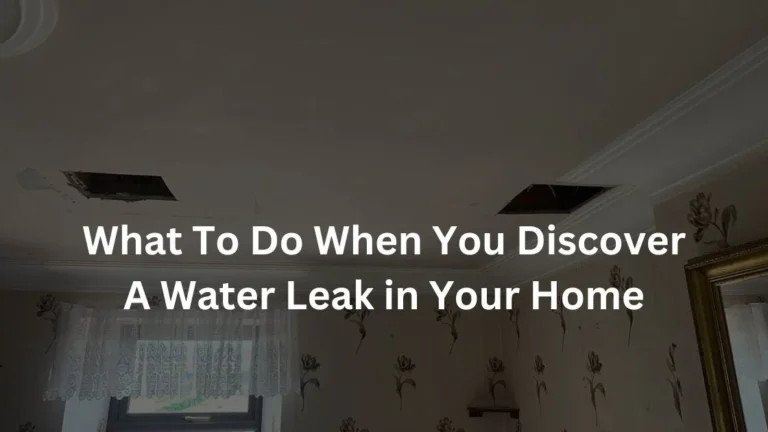Discovering a water leak in your home can be stressful and overwhelming, with the potential for significant damage if not addressed quickly. Knowing the immediate actions to take can make all the difference in minimising harm and protecting your property.
This guide provides a comprehensive set of steps to help you effectively manage a water leak, minimize damage, and protect your home and valuables. By following these steps, you can ensure your safety, document necessary information for insurance purposes, and restore your home efficiently.
Staying informed and prepared is key to handling such emergencies with confidence. So, let’s get into it!!!
Key Takeaways
- Shut off the water supply immediately to prevent further damage.
- Ensure electrical safety by turning off power in affected areas.
- Identify the source of the leak using signs like dampness, mould, or unusual water bills.
- Document damages thoroughly for insurance purposes, including photos and detailed notes.
- Contact your insurance provider to understand your coverage and next steps.
- Seek professional help promptly to fix the issue and prevent future problems
Turn Off the Water Supply
Upon discovering a water leak, the immediate priority is to turn off the water supply.
Locate the stopcock, typically found under the kitchen sink or near the water meter, and shut it off to prevent further damage. This swift action is essential for leak prevention, as even minor leaks can lead to significant water damage and mould growth within 24-48 hours.
Furthermore, check any isolation valves on appliances like washing machines or dishwashers to contain the issue. If the leak is severe, consider turning off the electricity supply to mitigate hazards.
After shutting off the water supply, run cold water until it stops to drain the pipes, relieving pressure and reducing the risk of additional leaks. Check out these other do’s and don’ts after a leak.
Ensure Electrical Safety
Ensuring electrical safety is crucial when dealing with a water leak, as water and electricity are a dangerous combination. Follow these steps:
- Turn Off Power: Turn off the electricity at the consumer unit (fuse box) before approaching any flooded area. Unplug affected appliances to prevent further damage.
- Use Safe Lighting: Use a torch instead of candles to avoid fire hazards.
- Wear Protective Gear: Wear rubber boots and gloves to minimize the risk of electrical shock.
- Get Professional Assessment: Avoid using electrical devices until a qualified electrician confirms it is safe.
These precautions will help ensure your safety during a water leak emergency.
Identify the Leak Source
Identifying the source of a water leak is essential for effective remediation. Don’t forget to check out these other questions you may have during a water leak emergency.
Common Leak Indicators
The telltale signs of a water leak can often be subtle yet significant, requiring keen observation to pinpoint the source effectively.
Recognising these indicators is essential for leak prevention and moisture control, enabling timely action to avert extensive damage.
- Damp or musty odours
- Mildew or mould growth
- Warped or buckled floorboards
- Visible water stains on walls or ceilings
- Unusually high water usage
Each of these symptoms is a clear warning that immediate action is needed. At PCLA, we often enter properties where the leak hasn’t yet been identified, but the strong damp smell, heavy condensation on windows, and mould growth around ceiling and wall junctions or behind furniture make it clear that a hidden leak is present. These indicators help us quickly determine that an unidentified leak is causing the damage.
Inspecting Hidden Areas
Uncovering a water leak often requires more than just noticing visible signs; it involves a thorough investigation of hidden areas that may conceal the source of the problem. Focus your inspection techniques on areas prone to leaks, such as under sinks, behind appliances, and near plumbing fixtures. Use a torch to identify dampness or water stains, and monitor for signs of mould, which may indicate hidden leaks.
| Area to Inspect | Signs to Look For |
|---|---|
| Under Sinks | Dampness, water stains |
| Behind Appliances | Mould, damp spots |
| Basements | Water intrusion, musty odour |
| Plumbing Areas | Leaking pipes, corrosion |
| Windows & Doors | Water stains, drafts |
Regular checks can prevent significant damage over time.
Monitoring for Leaks
In Northern Ireland, water usage is not typically metered for residential properties, so sudden increases in water bills aren’t a common indicator of leaks. Instead, focus on visually inspecting your home and using other techniques to detect such as the below to detect them.
Consider the following steps to monitor for hidden leaks effectively:
- Turn off all water-using appliances and listen for any dripping or running water sounds.
- Inspect common problem areas like under sinks, behind appliances, and basements.
- Look for signs of dampness, mould, or mildew, especially in less visible areas.
- Regularly check for water damage around plumbing fixtures, windows, and doors.
- Stay vigilant for any unusual changes in humidity levels or musty odours.
Remove Standing Water
Swift removal of standing water is essential to mitigating further damage after a leak. Even small amounts can lead to significant structural issues and mould growth within 24-48 hours.
To effectively manage this process, consider the following steps:
- Use pumps for large-scale flooding, especially in basements.
- Employ wet-dry vacuums for smaller amounts of water on carpets and hard surfaces.
- Safely dispose of removed water to prevent contamination and pest attraction.
- Verify all standing water is cleared before starting the drying process.
- Monitor the area for any signs of residual moisture to enhance moisture control.
Taking immediate action not only protects your home but also fosters a sense of belonging in a safe and dry environment.
Dry Affected Areas
Timely drying of affected areas is critical to preventing further damage and the onset of mould growth. Begin the drying process within 24-48 hours to considerably reduce the risk of mould, which can develop swiftly after water exposure. Employ effective drying techniques such as using dehumidifiers and fans to enhance air circulation.
Additionally, remove wet furniture and absorbent materials to expedite the drying process. Open windows to allow fresh air in, lowering humidity levels indoors. Verify that all surfaces, including walls and floors, are thoroughly dried to eliminate hidden moisture pockets that could foster mould growth.
| Drying Technique | Purpose |
|---|---|
| Dehumidifiers | Reduce humidity levels |
| Fans | Enhance air circulation |
| Remove absorbent items | Facilitate faster drying |
| Open windows | Allow fresh air circulation |
| Thorough surface drying | Prevent hidden moisture pockets |
Protect Valuables and Furniture
When faced with a water leak, protecting your valuables and furniture from potential damage is crucial. Immediate action can save cherished items and prevent costly repairs.
Consider the following steps:
- Raise furniture off the floor to avoid water exposure.
- Use plastic sheeting for moisture protection of important documents.
- Relocate upholstered furniture to dry areas to deter mould growth.
- Store valuables in a dry, elevated location out of harm’s way.
- Act quickly to dry affected items, preserving materials such as wood and fabric.
Contact Insurance Provider
After addressing immediate safety concerns, contacting your insurance provider is essential for managing the aftermath of a water leak.
Understanding the details of your policy coverage and effectively documenting damages will play a significant role in the claims process.
Clear communication with your insurer, combined with thorough records, ensures a smoother experience in recovering your losses.
Document the Damage
Immediate documentation of the damage caused by a water leak is essential for a successful insurance claim process. At PCLA, we frequently see insurers attempt to reject claims when proper documentation isn’t provided.
It’s crucial to substantiate the loss, which means providing solid evidence that clearly shows the extent and cause of the damage. This includes photographs, detailed notes, and receipts, all of which are necessary to prove your claim and ensure you get the coverage you deserve.
Begin by capturing clear photographic evidence of all affected areas, ensuring that you highlight visible mould, warped floors, and damaged personal belongings. This visual documentation will serve as vital support for your claim.
Furthermore, conduct a comprehensive damage assessment by recording specific details about the leak’s source and any potential causes.
Maintain a written log of events leading up to the leak, including dates, times, and any prior plumbing issues.
Ultimately, collect receipts for emergency repairs or mitigation efforts undertaken immediately after the leak’s identification.
These records will greatly bolster your claim and facilitate smoother communication with your insurance adjuster.
Policy Coverage Details
Upon discovering a water leak, it is essential to promptly contact your insurance provider to navigate the complexities of coverage.
Understanding the specifics of your policy can significantly impact the outcome of your claims process.
Here are key areas to discuss:
- Coverage limits for water damage incidents
- Policy exclusions, such as sewer backups or slow leaks
- Requirements for using licensed professionals for repairs
- Documentation needed to support your claim
- Expected timelines for claims processing
Filing a Claim Process
The urgency of notifying your insurance provider cannot be overstated when dealing with a water leak; timely communication is essential for an effective claims process.
To ensure a smooth claim submission, consider the following steps:
- Document the damage with clear photographs and videos.
- Categorise the water damage based on contamination levels (Category 1, 2, or 3).
- Keep detailed records of the incident, including notes on causes and timelines.
- Be aware of your policy exclusions to understand coverage limits.
- Follow up regularly with your insurer for guidance and restoration recommendations.
Taking these proactive measures not only strengthens your claim but also fosters a sense of community as you navigate this challenging situation together with your provider.
Engage Professional Help
Act promptly by calling a licensed plumber as soon as you identify a water leak that you cannot address independently.
Engaging an emergency plumber is essential, as their expertise in diverse repair techniques guarantees effective resolutions and prevents further damage to your home.
Before making the call, check your insurance policy for emergency call-out coverage; many policies provide assistance with costs related to leak detection and repairs.
Seek local plumbers who offer emergency services, as swift action can greatly mitigate water damage.
Furthermore, verify the credentials and reviews of potential plumbers to confirm they are reputable and experienced.
Document the situation thoroughly, taking photographs and noting the extent of the damage, to facilitate a smoother repair process once help arrives.
Monitor for Mould Growth

Prompt monitoring for mould growth is essential after uncovering a water leak, as mould can begin to develop within just 24-48 hours of moisture exposure.
To protect your home and health, consider the following mould prevention strategies:
- Maintain indoor humidity levels below 60%.
- Use dehumidifiers in damp areas, such as basements and bathrooms.
- Regularly inspect spaces prone to moisture for signs of mould.
- Address any visible mould immediately to prevent further spread.
- Consult professionals for safe mould removal and to resolve underlying moisture issues.
Worried about a hidden water leak in your home?
Northern Ireland’s top Domestic Leak Detection Service is here to safeguard your property!
Consider the damage a concealed leak could cause—structural issues, and hazardous mould. Our expert team uses state-of-the-art technology to detect leaks quickly and accurately, helping you avoid costly repairs.
Imagine the peace of mind you’ll have knowing your home is free from hidden water leaks. Our non-invasive, efficient detection methods ensure minimal disruption to your daily routine while providing maximum assurance. Trust Northern Ireland’s leading specialists to protect your home and family.
Don’t wait for leaks to cause significant damage. Contact PCLA, Northern Ireland’s trusted Domestic Leak Detection Service today.



